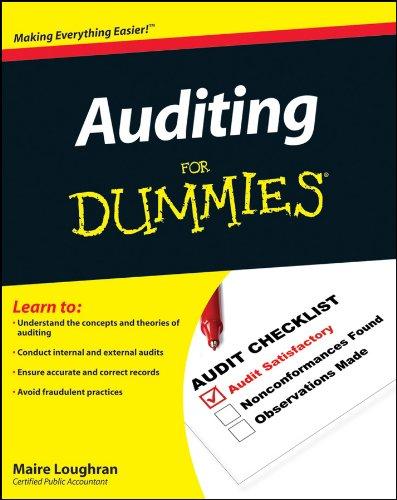The independent auditor is allowed to use a specialist for evaluating a complicated financial transaction provided the specialist is
| | knowledgeable and independent of the audit client. |
| | approved by the client's board of directors. |
Inappropriately dating transfers of funds between bank accounts to cover shortages of cash is properly referred to as
Cash equivalents
| | represent current assets that can be converted to cash within a year or an operating cycle, whichever is shorter. |
| | include only cash and highly liquid investments that are virtually free of risk. |
| | should be reported as investments and not be included as cash on the balance sheet. |
| | typically exclude money market funds and treasury bills. |
A cut-off bank statement primarily is used to
| | determine whether reconciling items on the year-end bank reconciliation have cleared the bank. |
| | prepare a year-end bank reconciliation. |
| | confirm the year-end balance of cash. |
An imprest cash account
| | typically is used for many large miscellaneous disbursements. |
| | typically earns large amounts of interest. |
| | is another name for the general cash account of an organization. |
| | is an account containing a stipulated amount of money to be used for a specific purpose. |
An auditor may estimate the appropriate amount of interest expense to be recorded by an audit client by multiplying the average debt by the average interest rate. If the auditor's estimate is considerably larger than the client's recorded interest expense this would be evidence of a potential
| | failure of the client to accrue interest expense at year end. |
| | the violation of significant loan covenants. |
| | overstatement of recorded interest expense. |
| | understatement of long-term debt. |
Internal controls over fixed assets in a smaller entity
| | usually include authorization by the board of directors. |
| | typically will be very similar to internal controls over other assets within the entity. |
| | must be the same as in larger entities. |
| | are of little importance since fixed assets are not subject to theft or misuse. |
A change in depreciation methods employed by an audit client resulting in a material change in depreciation expense
| | is not necessarily a violation of generally accepted accounting principles. |
| | requires disclosure by the audit client in the footnotes to the financial statements. |
| | must be noted in the audit opinion due to lack of consistency. |
| | is properly described by all of the listed statements. |
Auditors typically assess inherent risk for material accounts requiring significant estimates as
Which of the following loans from an audit client, which is a financial institution, made in accordance with the normal lending practices of the financial institution would impair the CPA's independence?
| | A loan fully secured by certificates of deposit from the same financial institution. |
| | A credit card loan in which the balance carried forward each month does not exceed $9,000. |
| | An automobile loan secured by the automobile. |
| | A home loan equal to less than 50% of the home's value and collateralized by the home. |
A CPA has obtained some original records from a client during the course of an audit engagement. At the completion of her audit according to the proper professional standards the client fired the CPA and demanded that the CPA return all of his original records immediately. Under these circumstances which of the following statements is most correct according to the AICPA Code of Professional Conduct?
| | The CPA may hold the original records she obtained until the client pays for the services she has completed. |
| | The CPA must return only the original records of the client upon demand regardless of the circumstances. |
| | The CPA must return all original records and all copies of original records of the client upon demand regardless of the circumstances. |
| | This is a matter of state law and not a matter covered by the AICPA Code of Professional Conduct. |






